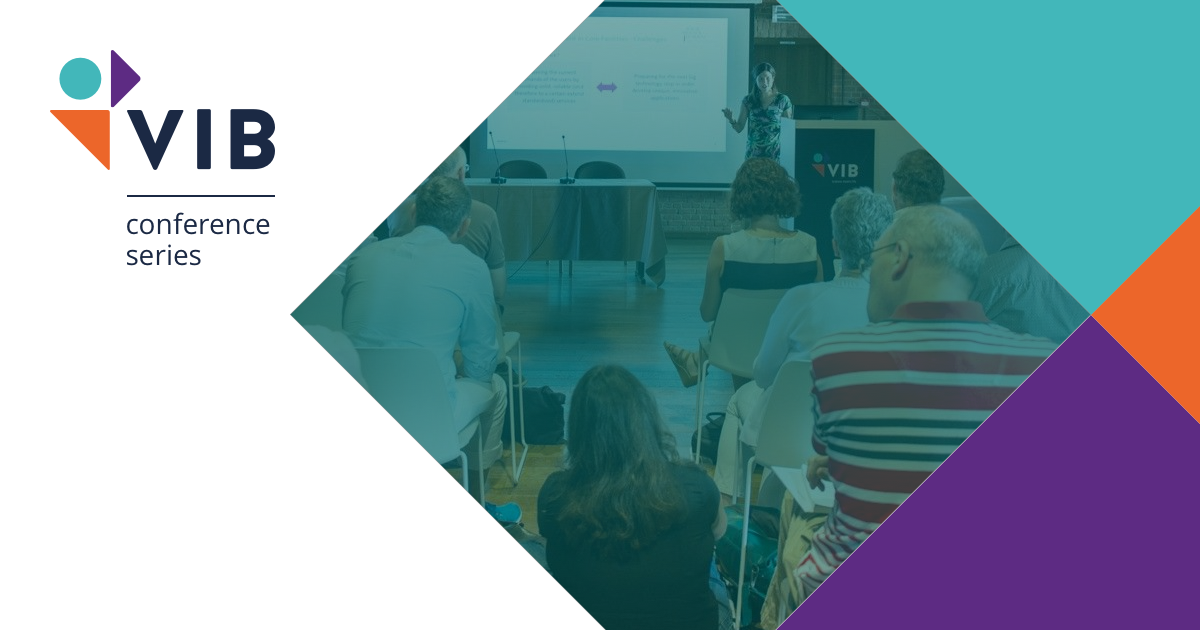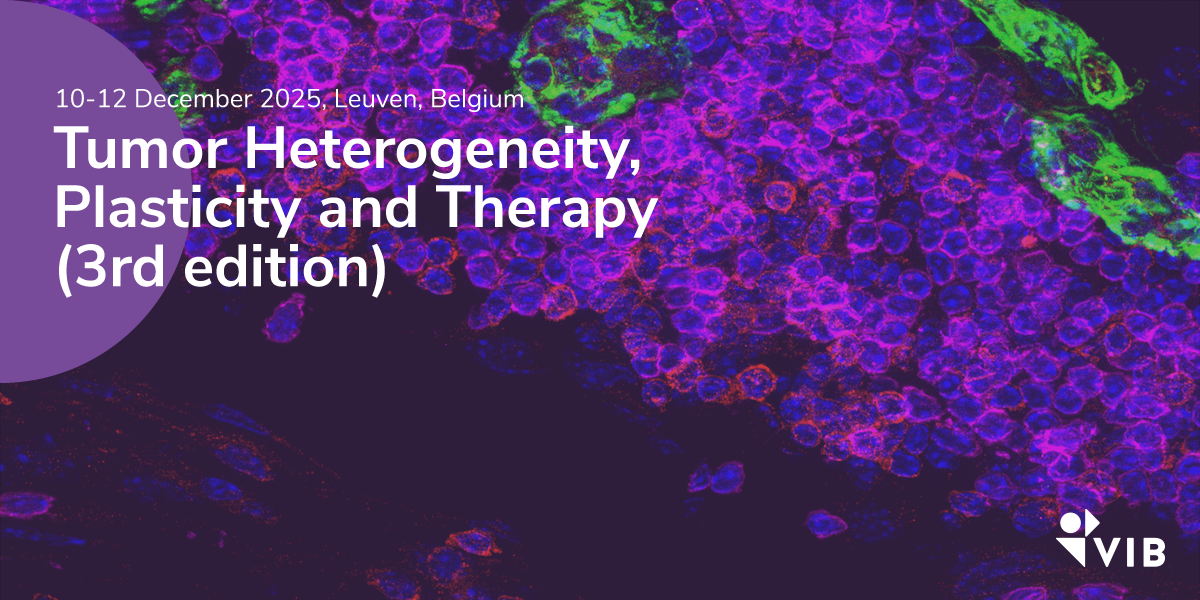“We need to start speaking the same language.”
A conversation with experts Damya Laoui and Chris Marine on decoding cancer’s complexity
Tumors are not simple. Even within the same tumor, cancer cells can behave in wildly different ways, making it difficult to predict how a patient will respond to treatment. This December, the third edition of the VIB Conference Tumor Heterogeneity, Plasticity and Therapy will gather leading scientists to explore how this cellular diversity drives resistance, metastasis, and – hopefully - new breakthroughs.
We spoke with Prof. Jean-Christophe Marine (VIB-KU Leuven Center for Cancer Biology) and Prof. Damya Laoui (VIB-VUB Center for Inflammation Research), members of the organizing committee, about what they’re looking forward to, the future of the field, and the personal paths that led them to cancer research.
Hi both, thanks for taking the time. Could you tell me something about your work?
Chris: My research focuses on tumor cell heterogeneity, so the idea that not all cancer cells within a tumor are the same. We know that certain subpopulations of cells have specific roles, such as promoting metastasis or resisting treatment. My group wants to identify and understand these cells so we can target them more effectively.
Damya: My lab works on tumor immunology, particularly the role of dendritic cells in shaping immune responses. We’re trying to understand where these cells localize in the tumor, what they do, and how we can harness them for new therapies.
Which speakers or sessions at the conference are you personally most excited about?
Damya: This meeting is a bit outside my comfort zone, since I’m more used to attending immunology conferences, so I’m excited to learn new things! I’m a big fan of Johanna Joyce, so I look forward to her keynote as well as the session on fundamental mechanisms of therapy resistance. It will be cool to dive into areas I don’t follow every day.
Chris: For me, it’s the opposite! I pretty much know all speakers well, so it’s hard to single one out. I’m excited about Mark Dawson’s keynote as he’s a close collaborator and friend. But I’m also curious about talks outside my usual scope, like Charles Sawyers’ work in epithelial and prostate cancer. Julio Aguirre-Ghiso’s work on tumor dormancy is another highlight. I’m generally looking forward to the meeting as a whole.

One of the conference’s main themes is therapy resistance. Do you see progress in predicting which tumors will become resistant?
Chris: The field is still developing. We’ve seen rapid progress in studying tumor heterogeneity, but the application to therapy resistance is just beginning. There’s growing excitement around using AI to predict treatment outcomes, but we’re not there yet.
Damya: The rise of single-cell sequencing is helping us collect more data before and after therapy. Specifically in immunotherapy, this helps us predict resistance, but we still don’t fully know how this links to tumor heterogeneity. There’s a gap between these fields, and meetings like this one can help bridge it.
Chris: Absolutely. Technologies are evolving so quickly. We’re learning more about dormant subpopulations and how they might survive therapy. We’re not in the clinic yet, but there’s reason to be optimistic that we’ll find new angles to target resistant cells.
If you had to place a bet, what will be the next game-changing idea or tool in tackling tumor plasticity or resistance?
Chris: Reprogramming cancer cells! If we can stop cells from entering resistant states, we can improve treatment responses. We’re also finding that different cancers use similar escape mechanisms, so understanding those could be game-changing.
Damya: For me, it’s personalization. Being able to tailor therapy to individual patients based on detailed molecular data. We’re making progress with biopsies and profiling, but the pace is still limited by cost and logistics.
How do you think the field is evolving in terms of collaboration between immunologists, geneticists, and clinicians? Are we bridging the gaps effectively?
Chris: There’s real progress. A few years ago, immunologists and cancer researchers were working separately. Now, especially with the rise of immunotherapy, the fields are converging, and you get researchers like Damya who can make the connection successfully. Computational biologists are also key players now, helping us interpret complex data. And we can’t forget industry. We’ve invited industrial partners to this meeting, because they’re an important piece of the puzzle to get these discoveries to patients. With clinicians, the gap is narrowing, but we need more clinicians who are also scientists.
Damya: Indeed, and that’s why these meetings are essential. We need to speak the same language. Some clinicians understand what we do, others don’t yet. By meeting here, we can form the right partnerships to translate research into trials and, ultimately, care. Hopefully, the young scientists and MDs attending this meeting will carry that integration forward.
Now onto some personal notes. If you could give your younger self one piece of advice before entering this field, what would it be?
Damya: To pay more attention in IT classes! I neglected those a bit... I don’t think I would have done much different, though. Science is a trial-and-error process.
Chris: I sometimes regret not having an MD background, especially as our work moves closer to the clinic. But I’m lucky to collaborate closely with a clinician, Oliver Bechter, so he’s compensating for that.
If you hadn’t become scientists, what path might you have taken?
Damya: After high school, I considered going to music conservatory - I played the viola -but people told me to do “real studies,” so I chose bio-engineering. My interest in science came later, but I’m happy I ended up here.
Chris: I actually once played for Anderlecht and the Belgian national youth team, before injuries sent me on a different path. I wasn’t exceptional, though, so I don’t know if I could have made a career out of football. I did learn a lot from team sports growing up, and those skills also helped me in science. This shows you that there is not one set path in science. What really makes the difference is that at some point, you feel the switch: this is what I want to do. That’s what matters.
Damya: Exactly! Sometimes friends tell me about their jobs, and that they often count the hours that are left. I can’t understand that. I never had this. So that’s a sign you’ve found your passion.
So that would have been completely different careers! But glad to see you ended up doing what you’re most passionate about. What part of your job do you find most satisfying?
Chris: I love the brainstorming phase: coming up with transformative ideas, reading widely, thinking about the big picture. And working with motivated young people in the lab. They have a lot of energy and can push you further. That’s one of the best parts.
Damya: For me, it’s definitely the real research part. I really like the point where we have a lot of data and we are writing the paper, and a lot of questions are popping up. As a professor, I have to teach a lot and there’s a lot of admin, so I don’t have as much time for it as I wish. It also gives me a lot of satisfaction to see young people grow. In the beginning, they are a bit naïve, but then they become real scientists. The first PhD student, who graduated from the lab, is now becoming a PI, and that makes me so proud.
Chris: When before they leave, the students start questioning you, that’s the best part [laughs].
And finally, what’s a book, podcast, or film that you would recommend to everyone?
Damya: I often recommend Deep Work by Cal Newport to young scientists. It teaches you how to focus for several hours to do the deep work you need as a scientist to get the best ideas.
Chris: I just started my summer read: Endurance by Levison Wood. It’s a collection of 100 stories about survival, challenge, and exploration. It’s about people facing major challenges and coming out the other side.
Thank you, both!
Want to join the experts? Register for the Tumor Heterogeneity, Plasticity and Therapy Conference on 10-12 December. The early bird deadline is 29 October!

Want to be kept up-to-date on our biotechnological news and stories? Join our community and subscribe to our bi-monthly newsletter.





